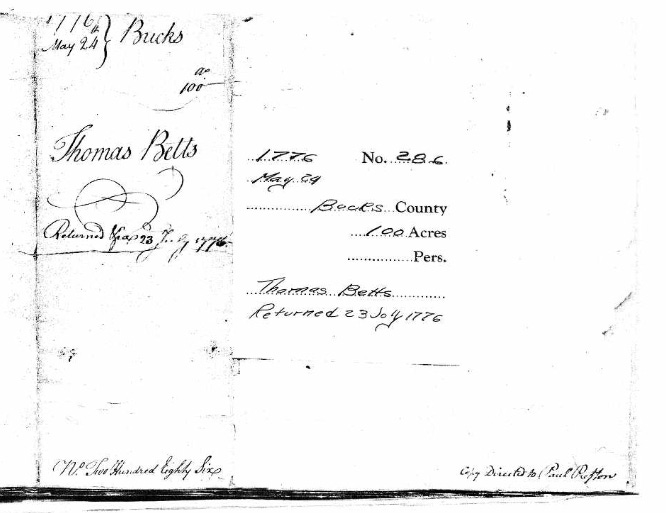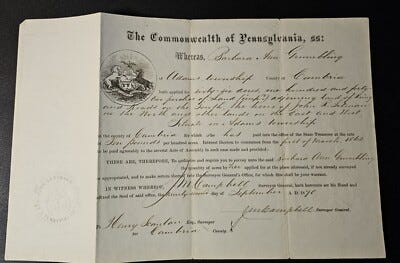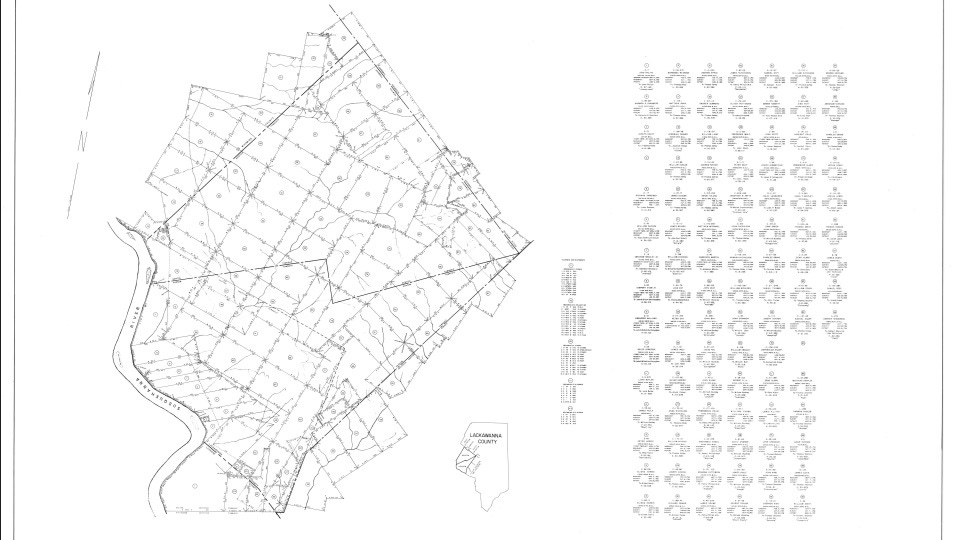Land Records for the Original Landowners of Pennsylvania
Land patent applications show your ancestor's location. The plat maps also show the neighbors. They may be related to your family or from your ancestor's hometown.
Tip by
Elizabeth Petty Bentley compiled many books for Genealogical Publishing Company. Her interest in genealogy started when her grandmother let her read the LaCoe book (the book lists the descendants of Anthony Desirè LaCoe, who was born on Mar 10, 1778, in France, and settled in Newton Township, Pennsylvania). Bentley went on to become a professional genealogist and passed her passion for research on to her daughter,
.Not All Records Are Online
The Pennsylvania State Archives is located at 1681 N. Sixth St., Harrisburg, PA 17102-11063. The Archives are open Tuesday through Friday and the second Saturday of the month, 9:00 a.m.–4:00 p.m. (except state holidays), admission is free, and no appointment is required (except for access to special or restricted holdings). Visitors can access original documents or microfilm copies. While some documents are available online, many of the land documents are available only on microfilm. However, the indexes to the land records are online. It’s best to do as much research as possible before visiting.
Land Warrants and Patents
The Archives houses the original land warrants and patents. The warrant application recorded a person’s intention to purchase a particular plot of land from the state. A warrant on that plot was issued to the person by the state.
“Unlike the applications for some other states, those in Pennsylvania rarely contain any information except the name of the applicant, the acreage, and the general location of the tract, nor do they normally bear the applicant's handwriting or signature. . . . On June 17, 1765, a new application system was implemented, making a formal application the required first step in the patenting process. The new procedures also introduced a new type of warrant, called a warrant to accept, that was granted after a survey was conducted. Under the new system, the applicant was to appear in person at the Land Office in Philadelphia, where his name, the date of application, and the description of the land were entered in a special application book. To curb speculation, each applicant was limited to a maximum of 300 acres.”
Ancestry.com has a searchable database of Pennsylvania, U.S., Land Warrants and Applications from 1733 to 1952 with images.
“Originally, a warrant was an order to conduct a survey and was issued by the Secretary of Proprietary Affairs upon receiving approval from either the Proprietor or the Commissioners of Property. The warrant specified the amount of land to be surveyed and, during the earliest years, whether the warrantee was an Original Purchaser, Under Purchaser, After Purchaser, renter or servant. If the warrantee was an Original Purchaser who purchased his right directly from William Penn, the warrant specifies the amount of land originally purchased.”
Surveys
“A Survey was the actual process of going upon the land and measuring and marking the courses and distances of the particular tract. Upon receiving a warrant or order to survey from the Secretary of the Land Office, the Surveyor General filed the warrant in his office in Philadelphia and sent a copy to the deputy surveyor for the county where the survey was to be made.”
Patents
“A patent was originally a deed from the Proprietor conveying legal title to the land described in the return of survey, subject to quitrents, and was the final step in the transfer of land to private ownership. The patent recited the information contained in the warrant and survey, including terms of purchase and the amount of quitrent.”
The patent indexes are available online. The Archives recommends searching this index if you did not find your ancestor in the Warrant Register.
Maps
Warrantee Township Maps are available for many of the counties, but not all. Maps are not available for all the communities in these counties.
“The Pennsylvania State Archives holds the following warrantee township maps, which show all original land purchases from the Proprietors or the Commonwealth made inside the boundaries of present-day townships. In essence, these maps serve as a summary and geographical index for the warrants, surveys and patents held by the State Archives. Information usually shown for each tract of land includes: name of warrantee, name of patentee, number of acres, name of tract, and dates of warrant, survey and patent. Survey and patent numbers also may be given.”
Additional Reading/Viewing:
Kris Hocker, "How to Use the Online Land Records at the Pennsylvania State Archives”
Kris Hocker, “TBT: Using Online Land Office Records at the PA Archives”
Cyndi’s List » United States » Pennsylvania » Land
Angus and Sharon Cook MacInnes, “State-Wide Resources and The Land Acquisition Process of the Colony and State of Pennsylvania, 1682-today”
Call for Contributors
Why should we all have to learn the hard way? Please share what you’ve learned. Email me at YourFamilyQuest@gmail.com
Upcoming Events:
Check your local times here.
Tuesday, 8 July 2025 at 10 am/1 pm (PT/ET) Mission Genealogy: Atlantic Roundtable
Tuesday, 8 July 2025 at 4 pm/7 pm (PT/ET) Mission Genealogy: Pacific Gathering Roundtable
Thursday, 10 July 2025 at 10 am/1 pm (PT/ET) Projectkin: Using a Potluck to Spark Family Storytelling with Cynthia Nims
Sunday, 13 July 2025 at 2 pm/5 pm (PT/ET) Projectkin: Looking at the Week Ahead
Thursday, 17 July 2025 at 10 am/1 pm (PT/ET) Emma Explores: Stories, Mysteries & Fame












Really useful information. Thank you.